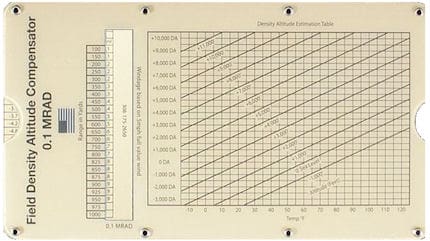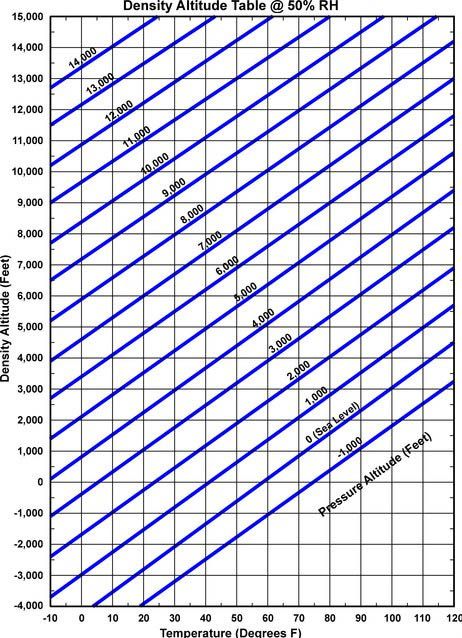In this age of gadgetry we're seeing more and more emphasis on barometric pressure (or density altitude) calculations when figuring your bullet's trajectory. Do these numbers really affect your bullet's flight? Yes--of course they do. But the question is, how much?
Our long range shooting training curriculum places a strong emphasis on freeing ourselves as much as possible from dependence on anything that requires a battery. It is our belief that if you become too dependent on your smart phone or your Kestral--or even your range finder, you're going to be rendered largely ineffective in a situation where you don't have these amenities. (And we must now wonder how anyone ever worked without these things, too, right?)...
How does one get along without a range finder? Ranging targets in the real world with a reticle is extremely inexact (you won't have nifty little 18" squares to mil anywhere except on a rifle range, most likely). But you can make range cards using that LRF when it is working, and light conditions are favorable to good readings. And failing that, working in the "off season" you guesstimate the range, make a shot, note the impact, correct the scope setting, hit the target, then record that info on the range card. I'm digressing here, I know... but I figured the question would come up about LRF's so I brought that out...
Barometric pressure can only be known though the use of electronic devices (and you'd be surprised how these things can give different readings from the SAME place sometimes). You can go to Weather Bug on your phone, and it'll tell you... if you have Kestral, it'll tell you... but if electrons cease to flow through your wires, you're out of luck. How bad might that end up being?
Actually, not as bad as many would lead you to think. If you're using a decent long range bullet (and if you're not, you've got no business shooting it past 500 yards), then the average barometric pressure swings in a given area are not going to be enough to move you more than a half minute off vertical at 1000 yards. I shoot mostly the 178 Hornady AMAX these days, at about 2620 fps. By looking at the yearly highs and lows for barometric pressure in my area, I can see that the most I'd be high or low (if I base my drop chart on the average) would be about 5 inches at 1000 yards. Heck, I miss by that much anyways most of the time.
Here is a local weather station chart for my area. Note the barometric pressure high and low for the year...
Weather History for Weather Station KVAWYTHE1 | Weather Underground
If you're using a bullet that has a higher BC than my .308 bullet does, and especially if you're driving it faster, you'll see even less of an issue.
NOTE: I'm not saying that you should disregard your barometric pressure input (or density altitude adjustment) if you have access to that information. I'm simply saying that you ought to make yourself aware of what to expect in your given area as far as pressure swings throughout the year.
The big things affecting your trajectory are altitude and temperature. If you're keen on these two numbers, you should be able to hit within 1 MOA high or low at 1000 yards with any decent long range load recipe. And temperature and altitude are two things that are not hard to know without your smart phone or your Kestral or whatever.
Dan
Our long range shooting training curriculum places a strong emphasis on freeing ourselves as much as possible from dependence on anything that requires a battery. It is our belief that if you become too dependent on your smart phone or your Kestral--or even your range finder, you're going to be rendered largely ineffective in a situation where you don't have these amenities. (And we must now wonder how anyone ever worked without these things, too, right?)...
How does one get along without a range finder? Ranging targets in the real world with a reticle is extremely inexact (you won't have nifty little 18" squares to mil anywhere except on a rifle range, most likely). But you can make range cards using that LRF when it is working, and light conditions are favorable to good readings. And failing that, working in the "off season" you guesstimate the range, make a shot, note the impact, correct the scope setting, hit the target, then record that info on the range card. I'm digressing here, I know... but I figured the question would come up about LRF's so I brought that out...
Barometric pressure can only be known though the use of electronic devices (and you'd be surprised how these things can give different readings from the SAME place sometimes). You can go to Weather Bug on your phone, and it'll tell you... if you have Kestral, it'll tell you... but if electrons cease to flow through your wires, you're out of luck. How bad might that end up being?
Actually, not as bad as many would lead you to think. If you're using a decent long range bullet (and if you're not, you've got no business shooting it past 500 yards), then the average barometric pressure swings in a given area are not going to be enough to move you more than a half minute off vertical at 1000 yards. I shoot mostly the 178 Hornady AMAX these days, at about 2620 fps. By looking at the yearly highs and lows for barometric pressure in my area, I can see that the most I'd be high or low (if I base my drop chart on the average) would be about 5 inches at 1000 yards. Heck, I miss by that much anyways most of the time.
Here is a local weather station chart for my area. Note the barometric pressure high and low for the year...
Weather History for Weather Station KVAWYTHE1 | Weather Underground
If you're using a bullet that has a higher BC than my .308 bullet does, and especially if you're driving it faster, you'll see even less of an issue.
NOTE: I'm not saying that you should disregard your barometric pressure input (or density altitude adjustment) if you have access to that information. I'm simply saying that you ought to make yourself aware of what to expect in your given area as far as pressure swings throughout the year.
The big things affecting your trajectory are altitude and temperature. If you're keen on these two numbers, you should be able to hit within 1 MOA high or low at 1000 yards with any decent long range load recipe. And temperature and altitude are two things that are not hard to know without your smart phone or your Kestral or whatever.
Dan





